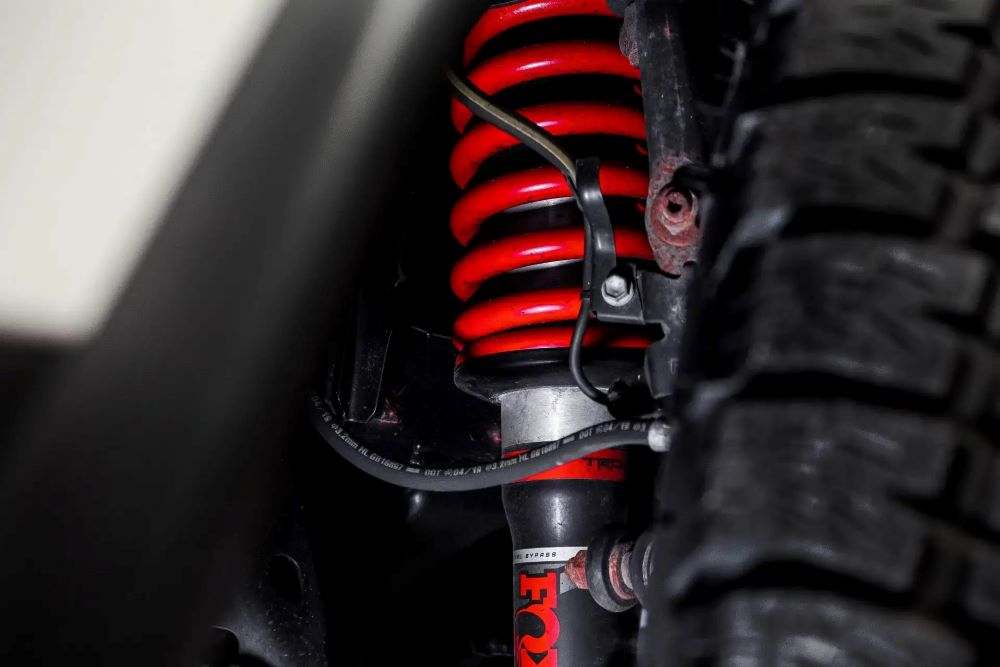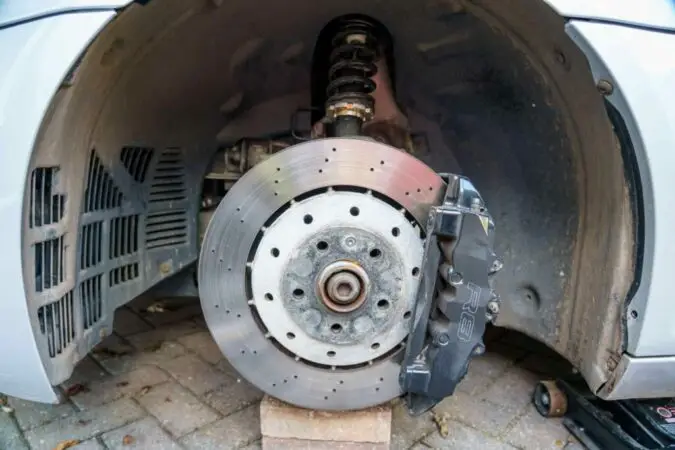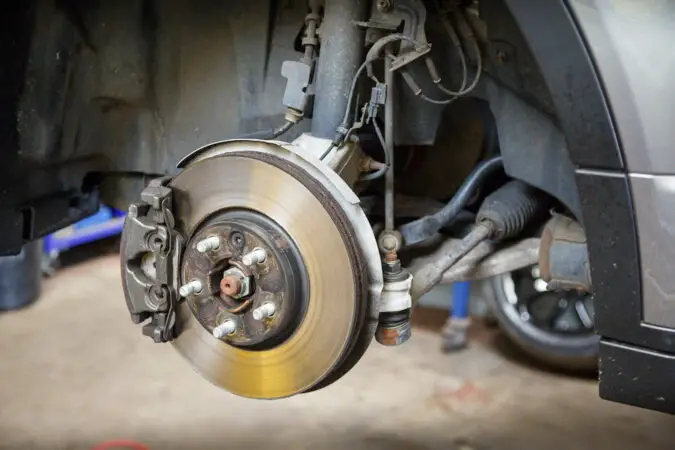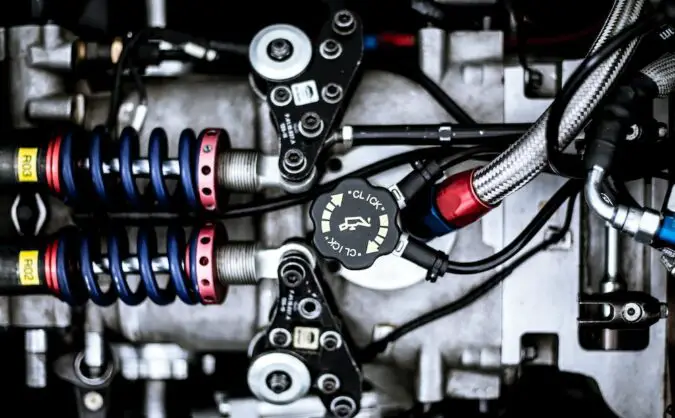Because your car was designed to endure, it can go hundreds of miles without requiring maintenance. What if crucial elements such as rear struts break down? You’ll need the help of a professional mechanic or discover how to repair the problem yourself.
- What Are Shocks?
- What Are Struts?
- Why Should You Replace Them?
- Rear Struts Replacement Cost
- Front And Rear Struts
- Rear Struts Leaking
- Rear Struts Replacement
- Symptoms Of Bad Rear Struts
- Frequently Asked Questions
The good news is that many repairs are quite easy to do at home. Shocks as well as front and rear struts, replacement is a simple process, for example. Don’t attempt this job if you’re unfamiliar with automobiles; nevertheless, with some training and expertise, you’ll be ready to go.
In most cases, it should not take more than a few hours to get back on the road.
You’ve arrived at the correct location if you’re searching for a way to repair your automobile’s shocks and struts. We’ll clarify the differences between them and how to replace them so you may save money in this blog post. Continue reading if you’d like additional information.
What Are Shocks?
Shock absorbers, often known as shocks, absorb the impact of road irregularities. They absorb the kinetic energy generated by driving over a rough surface. They keep your vehicle from bouncing, allowing for a pleasant trip for you and your passengers.
Shocks boost your car’s traction and control, allowing it to remain straight when turning and at higher speeds on the highway. These aren’t the same as the front and rear struts, so if you have both, replace them at the same time.
What Are Struts?
Struts, on the other hand, are physical components of your automobile. They complete the suspension system and ensure that your automobile moves smoothly and efficiently. Not to mention that they dampen spring vibration to minimize suspension damage.
Struts are composed of strut housing that provides structural support for the construction and a damping unit within it to control spring and suspension movement.
On most struts, the body connects to the steering knuckle through a lower ball joint and then to a lower control arm.
The strut assembly is a single item that contains all of the components required for strut replacement. It supports the vehicle’s weight with the strut housing, damping unit, and coil spring.
Front and rear struts and shocks may be found on certain vehicles. Others only have one or the other. It’s critical to know the difference so you can anticipate what you’ll face once you get beneath the hood.
so, shocks or struts, what suspension configuration is in my vehicle?
Your vehicle has two types of suspension: shocks and struts. However, your automobile may have front shocks but lack back struts or come in some other configuration. The most important thing to remember is that each wheel has a ride-control component.
Why Should You Replace Your Shocks and Struts?
Shocks and struts are two of the most important elements in your car. With time, like other components, these parts wear down, resulting in everything from an unpleasant driving experience to damaged tires.
If you’re noticing a delay in stopping, or if the ride is severely jarring, your vehicle’s front and rear struts, are probably worn out. It’s crucial to check them regularly because they may deteriorate with time, not only because
Rear Struts Replacement Cost
Even if one of the struts appears to be in good shape, you should replace them both in pairs. You may have serious handling and suspension concerns if you don’t, which can lead to dangerous driving situations and costly damage.
Struts are not always cheap to replace. The cost of replacing front and rear struts varies greatly based on the type of struts (usually KYB, Monroe, Gabriel, or Bilstein), the make and model of your car, and where you have them replaced.
On average, a set of struts costs between $450 and $900 to replace. You’ll spend around $300 to $600 on parts alone because each strut assembly costs roughly $150 to $300 in most cases. In most situations, labor for the rear struts replacement cost is around $150 to $300.
Front And Rear Struts
The struts in your automobile’s suspension system are an important part of the system. They’re structural and fastened to the vehicle’s chassis top. The coil spring, which keeps the car at a consistent height, is supported by struts. Both front and rear struts are extremely necessary.
Unfortunately, they will eventually wear down. When do you need to change them? Let’s have a closer look at it.
If your automobile is bouncing more than normal or feels extremely rough when going over potholes, or if your mechanic finds the rear struts leaking fluid or have been damaged, you’ll need to replace the struts. You may also find that they have rust in some places.
The struts in a vehicle with a strut-type suspension are the “shock absorbers” installed inside the coil springs. They are commonly used since they make suspension systems more affordable and replace other kinds of shock absorbers.
Springs absorb road shocks, allowing them to control the amount of bouncing generated by bumps, dips, and rises in the roadway. The term “shock absorber” is a misnomer since the springs absorb the shock.
Struts lessen the bouncing produced by the springs compressing and relaxing. Instead of “shock absorbers,” they should be referred to as “dampers.”
The faster your struts wear when you transport heavy items or travel on severely difficult roads, the more often they will have to be replaced. If you don’t abuse them, though, they may survive a vehicle’s entire life.
Don’t just request new struts from the mechanic if you have a problem with your automobile; instead, explain what’s happening and allow an expert to determine whether worn struts are to blame. You might have a different suspension issue, or your vehicle may be suffering from something else entirely.
Rear Struts Leaking
For a variety of causes, including roadside debris damage, rear strut seals can develop leaks. A leak in the rear struts is an indication that your suspension is faulty.
Fortunately, repairing this problem is straightforward. If you find rear struts leaking, perform the following procedures.
1. Find The Problem
When it comes to determining whether or not your struts are leaking, you must first pinpoint the source of the problem. Old components are frequently to blame for rear struts leaking. The seals on the struts may become brittle with age, preventing liquids from staying within the system.
Examine the struts for any damaged or lost seals. If your struts are new and in excellent condition, they may be leaking due to a collision that affected the suspension system and bent or dented the struts.
If you can’t seem to figure out what’s causing your struts to leak, get help from an expert.
2. Preventing Rear Struts From Leaking
Rear struts leaking can cause significant driving difficulties, but they may be avoided if you follow the instructions listed below.
2.1. Inspect Your Suspension Regularly
Check your automobile’s suspension components regularly to ensure that they’re in good working order. If you notice any issues, however minor, have them repaired as soon as possible to avoid additional damage.
2.2. Replace Your Struts As Needed
The lifespan of your car’s struts is determined by the number of miles you put on them. However, it is recommended that they be replaced every 50,000 miles. So make sure you keep track of how much mileage you put on your automobile and replace them when necessary.
If you replace your struts, you will be able to prevent them from leaking as well as enjoy a smooth ride for many years.
Rear Struts Replacement
The “bounce test” used for shock absorbers does not apply when dealing with struts. A strut will that is severely worn easily passes this test. Instead, rely on your senses and do a road trial instead.
Replace both struts at the same time. If the issues with your struts persist, have them replaced straight away:
- Rear struts leaking. A tiny quantity of oil around the strut is acceptable, but fluid dripping down one side indicates that it’s no longer there.
- When you apply the brakes, you may notice bounce or sway.
- On difficult surfaces and turns, it might be tough to keep the automobile in its lane.
- Tires have shallow craters as a result of tire bounce.
- Damaged or misalignment in the strut boot.
Step 1. Go For The Complete Strut Assemblies
An entire strut assembly contains new parts that are ready to install: a strut, spring, jounce bumper, strut boot, spring seat insulator, bearing plate, and strut mount.
If you’re looking for a full strut assembly, go to an automobile parts shop or buy from an auto part supply online. They’re often available for many brands and types of vehicles.
The rear struts replacement cost varies, although they are a preferable option since they let you do the whole job by yourself and get new parts.
The vehicle’s original ride height as well as firmness are restored, as well as smoother turning. The operation is also much quieter.
An angle gauge is required to have the strut as well as the wheel aligned at least close enough that you can drive to the mechanic for a more professional alignment. A mechanical or digital angle gauge will suffice.
Step 2. Measuring The Angle Of The Camber
Remove each component on the strut one at a time. start with one side and then the other side, paying attention to the alignment and the location of the nuts and the bolts. Use the opposite side as the reference for placement.
Jack up the car and use a jack stand to support it. Wash the strut flange nuts as well as the bolts using a rust penetrant. Next, spray the strut-tower mounting bolts.
To mount the rotor onto the hub, spin two lug nuts on and tighten them. Measure the angle of the rotor top using an angle gauge.
Step 3. Disconnecting End Link
Remove the end link as well as the brake lines connected to the strut after this. Grasp the end link using a wrench. Loosen the nut using a socket and ratchet.
Remove the cotter pin and push out the end link from its strut hole onto the side. Remove the speed sensor wire from the wheel.
Step 4. Take Out The Nuts And The Bolts
Remove the lock nut and bolt. If the bolts are difficult to remove, try loosening them by gripping them securely and leaning in. Remove the bolts after removing the locknuts. Wiggle the steering knuckle to remove the bolts.
Step 5. Separate Strut And The Knuckle
Remove the strut cap by prying it off with a pry bar. Remove the strut. Using a pry bar, prise the knuckle out of its position in the strut flange.
Step 6. Take Out Mount Nuts Of The Struts
Place a small plywood piece beneath the strut flange. This prevents it from causing damage to the CV boot when you remove the top part of the strut. Loosen all of the nuts on the strut mount at the strut tower with a ratcheting wrench or socket/ratchet. Remove only one and one of them
Step 7. Take Out Strut
Remove the last bolt by supporting the strut as you get into the wheel well and tilting the spring downward. While gripping the spring and the strut bottom, shift the bottom of the spring and push it outwards toward you. After that, bring down the strut till it is off the strut tower, then remove it.
Step 8. Put In New Strut Then Reset Angle
The installation is the opposite of removing now that you’ve gotten over the rear struts replacement cost. Getting the new strut into position and tightening the bolts may seem difficult. As a result, enlist the assistance of someone else during the installation. When installing the strut mount nuts, torque them to the manufacturer’s specifications after they’ve been in place.
Set up a bench block to keep your automobile in place while you remove and replace the steering knuckle. Insert one bolt into one hole, and press the steering knuckle inside the strut flange using the pin punch. Then adjust the angle gauge until you can reach as near to the original camber angle as possible.
Install the camber and torque the bolts to specified specs. If required, adjust it as necessary. Connect any disconnected components such as a stabilizer bar end link or the wheel speed sensor wiring harness, if applicable.
Step 9. Get Alignments From A Professional
This procedure merely gets you back where you were before you replaced the struts. It isn’t, however, a suitable alternative for an expert alignment. Because improper camber can result in tire wear, have your vehicle adjusted by a professional mechanic as soon as feasible. We’re not talking several months later here.
The majority of automobiles have a fixed camber, which is the only alignment specification (measure) that would be affected by rear struts replacement. Instead, your vehicle has adjustable camber settings, so it will need to be aligned if the struts are replaced.
If you replace the new struts correctly, you may wait until after you have your new tires to do the alignment. However, this implies that the alignment is not very off-spec. If there is any looseness in rear-end components before receiving an alignment, it will be pointless.
Symptoms Of Bad Rear Struts
1. Bumps Knocking Noises
The entire weight of the car is carried by the struts. The wheel assembly connects them to the chassis directly. As a result, when you drive over a pothole on your vehicle’s road surface, the struts absorb any motion and leave you unaffected.
Struts, like other suspension components, can wear out and make noise. It’s conceivable that a strut will break at some point; you’ll hear a knocking sound if you hit a pothole or other road obstacle. Over time, the internal components of the strut, such as the shock absorbers and bushings, may wear down and create
If you hear an odd noise near the rear of your vehicle, these are symptoms of bad rear struts and it’s time to get a professional inspection. A skilled expert can determine if you require a new one.
2. Height Of The Car Is Tilted To One Side
The coil spring, which is a component of the struts, supports the weight of your automobile. The coil springs maintain your car at a constant height. If the coil spring fractures, the length of the spring is reduced, causing your automobile to lean one way.
This is difficult to notice since the distance from the tire to the fender is typically minor. However, if you compare the distance between the tire and the fender, you may frequently detect a difference. These are usual symptoms of bad rear struts.
3. Seepage Of Hydraulic Oil
A typical strut is filled with hydraulic oil. Over time, the seals on the strut may deteriorate, allowing oil to seep out. When this occurs, you’ll notice an oily residue around the outside of the strut.
When you discover that your struts are leaking, these are symptoms of bad rear struts. there’s no time like the present to figure out what the problem is. Old parts are frequently to blame for dripping shock absorbers. The seals on the struts can become brittle over time, preventing them from keeping liquid within the system. To look for any damaged seals or strut deterioration.
If your struts are relatively new, rear struts leaking could be a result of an accident that damaged the suspension system and bent or dented the struts. They are sure symptoms of bad rear struts. If you can’t identify the source of your struts’ leaks, expert assistance is recommended.
4. Suspension Is Bouncy
The suspension failure will not suffice to pass inspection, as it did in the previous example. If your vehicle has a bouncier and bumpier ride than usual, then these could be symptoms of bad rear struts. One or both of its front or rear strut shocks may be worn out or even destroyed.
When the function of the strut is complete, the suspension spring’s vibrations are no longer effectively managed. When traveling over bumps, this produces an unpleasant ride. If not addressed promptly, the struts may eventually wear down to the point where they cause the vehicle to “bottom out,” which is when the spring compresses enough to touch the bottom.
However, a rough trip does not always imply shock absorber failure. Bushings can also fail, causing trouble. As a consequence, it’s always better to seek advice from an expert. He has the authority to make decisions on his own. If you are advised that both struts and the shock absorbers should be replaced.
5. Tires Wear Out Unevenly
Rare symptoms of bad rear struts include uneven wear of tires. However, if the coil spring broke and the car was lowered, this may happen as a result of the wheel alignment being relocated.
Cupped tires are a classic indication of worn-out struts. Because the strut isn’t able to properly dampen the spring, the wheel/tire assembly bounces up and down while driving. As a consequence, the tires develop high and low areas across the tread known as “cupping.”
Worn strut mounts can also mess up the car’s rear-end alignment, resulting in excessive tread wear on the inside or outside of the tire. If you detect uneven tire wear, schedule your suspension struts to be inspected and have a new wheel alignment performed after the rear struts replacement.
Don’t expect struts to be cheap. Furthermore, if you replace one set of struts, you must replace the other side as well. Otherwise, your car will not be correctly positioned.
You should have your struts checked and updated as soon as you notice the first signs of failure. The longer you put off having your struts repaired, the more the rear struts replacement cost.
Frequently Asked Questions
How To Replace Rear Struts
Remove the steering wheel. Disconnect the end link, loosen and remove the nuts and bolts, separate the strut and knuckle, and remove the strut mount nuts before shifting to a new car. Installing a new strut is straightforward if you know what you are doing.
How Much To Replace Rear Struts
While shocks are much cheaper, rear struts replacement cost is high. On average, a pair of struts costs between $400 and $1000 to replace, including wheel alignment. A strut assembly costs between $150 and $350 while labor fees vary from $100 to $300 for a pair.
How To Tell If Rear Struts Are Bad
Some of the signs of damaged struts include oil seepage, vibration, strut noise, uncomfortable ride, abnormal tire wear, and reduced handling ability/braking performance. This will usually require you to consider the rear struts replacement cost.




